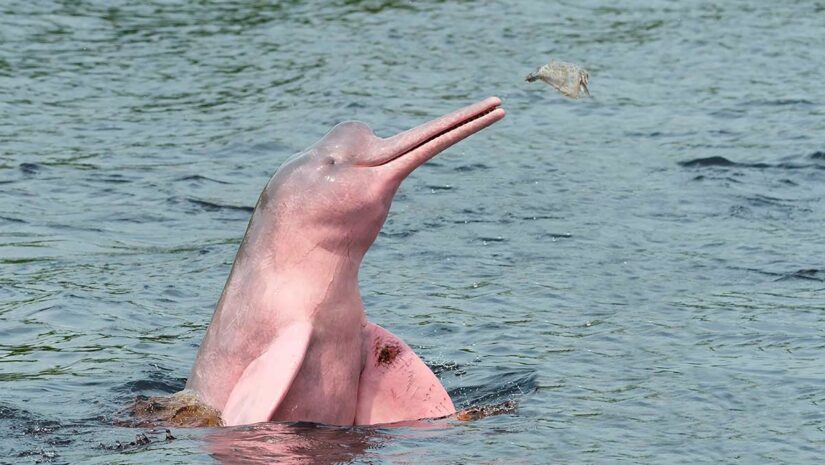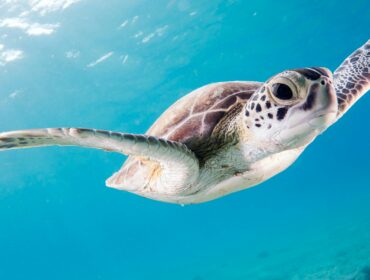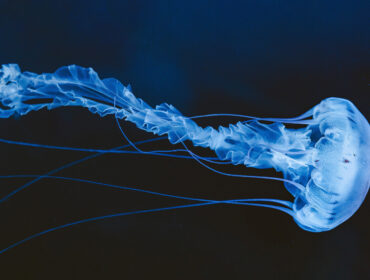Vibrantly colorful and naturally aloof, the Amazon Pink River Dolphin is not just a mythical creature of Amazonian folklore. This species exists throughout the Amazon River in basins all over South America. It’s an adaptive breed that has supported the freshwater ecosystem but now faces shared ecological challenges that the damaging human presence has created in their habitat.
This dolphin live a long life in the wild, creating strong bonds with its young and working together with other species to continually enjoy snacking on river fish. The Pink River Dolphin is a mysterious creature that needs our support and protection to continue existing in the waters of the Amazon.
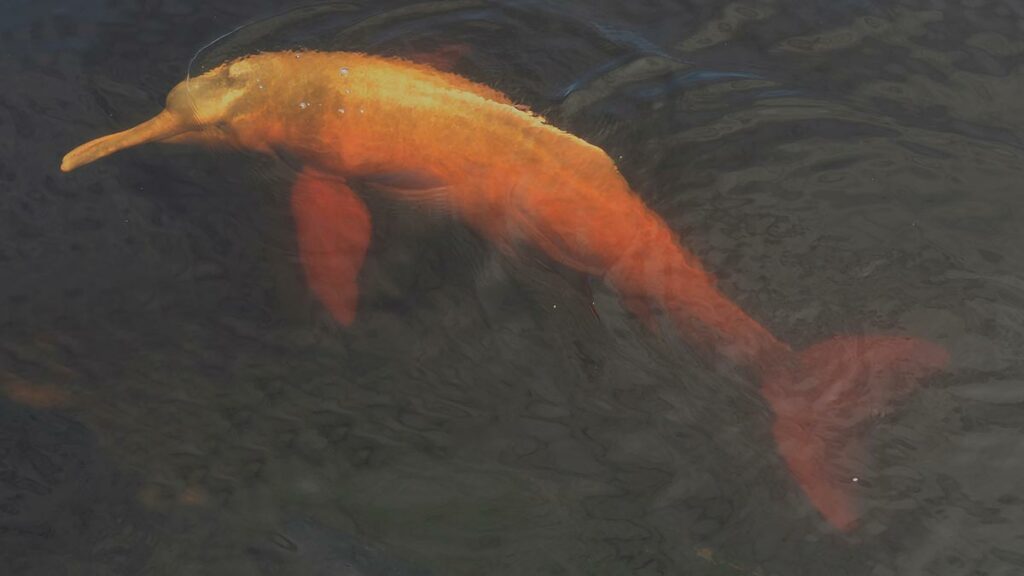
What is the Amazon pink river dolphin?
The Amazon pink river dolphin is a mammal that lives in fresh water. It is also known as the Boto or Amazon River dolphins. Its scientific name is Inia Geoffrensis and was first described in 1817. This species is categorized as toothed whales and are instantly recognizable by their pink skin. This is most prominent in males and stands out in the murky water of the Amazon River. They are a very agile species who swim slowly but have an unfused vertebrae, giving them great maneuverability through the obstacles of the Amazon. They keep a low profile, often only bobbing their head out of the water.
Characteristics
This species of dolphin is more robust than the well-known bottlenose dolphin. What makes it unique and easy to spot from other creatures is their pink skin. They are also the largest river dolphin species. Males can grow over 8 feet or 2.4 meters and weigh up to 408 pounds or 185 kilograms. Females are notably smaller at almost half the weight and shorter in length of the males. They have a long rostrum full of small, sharp teeth, and a bulge on their head known as a melon, which is the organ used for bio sonar. Amazon river dolphins have a shallow and long dorsal fin.
Habitat
As the name suggests, Amazon pink river dolphins live in the Amazon River. This includes basins in seven southern American countries — Brazil, Venezuela, Colombia, Peru, Ecuador, and Guyana. They are also found in Orinoco river basins.
Female and male pink dolphins have different preferences in habitat. Males will spend most of their time in the main river while females will spend as much time as possible in flooded shallow areas to protect their young from predators. Dolphins adapted from sea water to freshwater when their ancestors were able to easily access rivers due to higher sea levels millions of years ago.
Behavior
Amazon pink river dolphins communicate by making a clicking sound. They do this to better navigate their environment and to interact with other dolphins. As the Amazon river is full of vegetation in shallow water, dolphins will sound off 30 clicks per second to gauge their surroundings. In terms of intelligence, pink dolphins are considered to be smartest — in fact they have 40% more brain capacity in comparison to humans. This means these dolphins have the ability to use their brain in ways humans cannot. That, coupled with their emotional intelligence, means there is a lot of potential for humans to learn from observing pink river dolphins.
Diet
Pink dolphins are fortunate enough to have one of the most varied diets of any toothed whale. They can dine out on over 50 different fish species averaging 20 centimeters or 7 inches in length. The dolphins’ many teeth mean they can eat shelled marine life such as river turtles or freshwater crabs. Fish species they can enjoy include tetras, catfish, and piranhas.
During one day, an Amazon pink river dolphins will try to consume 5.5% of their body weight and are actively feeding day or night. They can work with other species when hunting but tend to have plenty of food so that they do not have to compete.
Life Span
Marine biologists have been unable to establish how long Amazon pink river dolphins can live in the wild. The oldest captive pink dolphin lived for 46 years. Considering marine species struggling in captivity, it is possible in the wild these dolphins are able to live much longer. With such a potentially long life span, it is not surprising that pink river dolphins do not mate until later in life, around a decade after they are born. Mating season is in late October and early November with births occurring during the flood season in May and June. The mother forms strong bongs with her calf, and the two often stay together for up to three years.
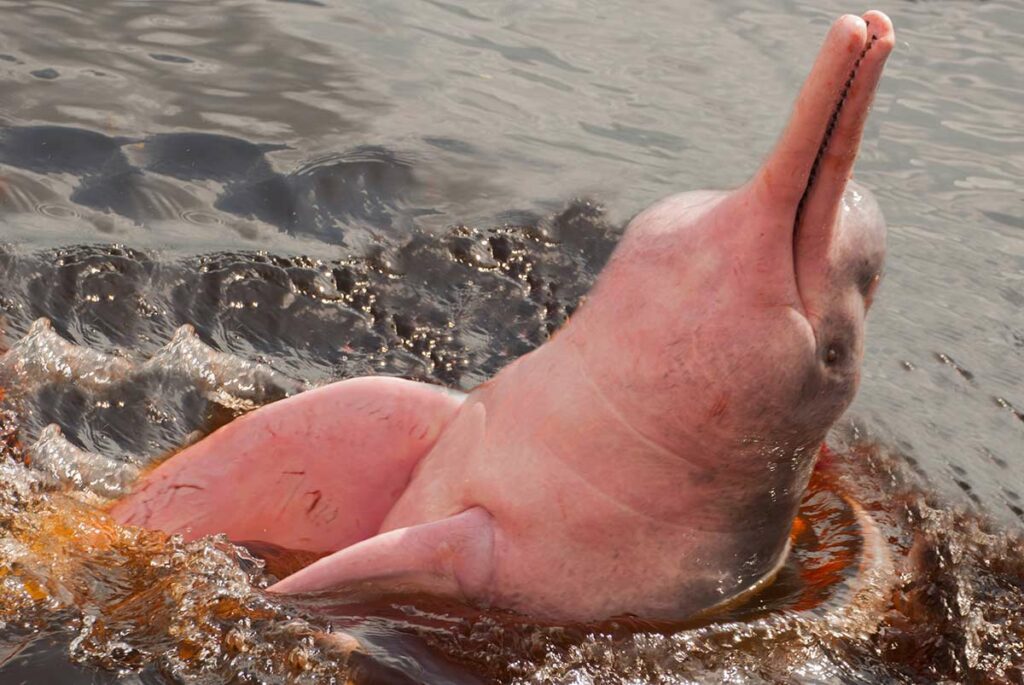
Threats and Conservation Status
Pink river dolphins are endangered. It is hard to estimate the total number as this species lives in such a vast area that covers many territories. While there are large numbers, humans still present an ever-looming threat. Water infrastructure (such as dams) present a real threat to Amazon pink river dolphins by splitting up habitats and disrupting water flow and marine compositions.
Commercialized fishing practices, which recklessly tangle dolphins in their nets, kill dolphins and upset the ecosystem of the river. The killing of Amazon river dolphins remains illegal. Water pollutants from human activity make their way into the waters of the Amazon, which can cause illness and death to dolphins. Due to their size, Amazon pink river dolphins do not have many predators in nature unless a smaller dolphin crosses paths with a sly anaconda or prowling jaguar.
Cultural Significance and Mythology
Indigenous tribes who have dwelled near the Amazon River for centuries believe varying mythology around the significance of the Amazon pink river dolphin. A shared belief is that it is bad luck to harm these creatures. In fact, some believe that by even making eye contact with these creatures you can risk a lifetime of nightmares.
Much folklore surrounds the shapeshifting abilities of the pink dolphin, known as Encantado, who transforms into a human at night and lures locals. Versions of this tale vary, but Encantado is believed to entice men and women, casting spells and luring humans to the underworld from which no one has ever returned.
Making peace with the Amazon pink river dolphin can also lead to sightings of Amazonian manatees, as the dolphins act as their guardians. One theme is clear: being respectful and wary of these creatures is important within Amazonian culture.
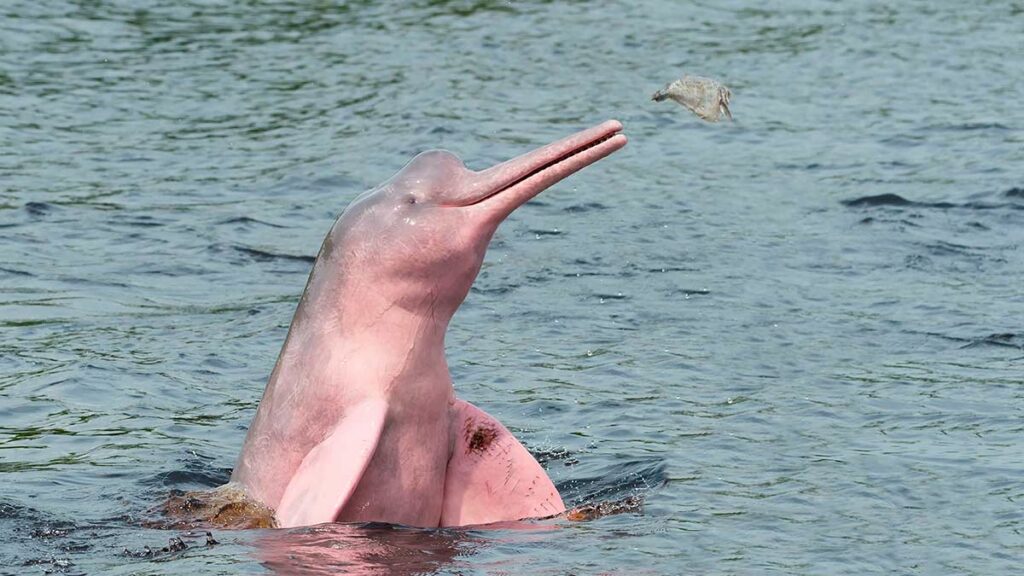
Ecotourism and Awareness
It is important to raise awareness of this unique species to promote their protection and educate people on the importance of respecting them and their habitat within the Amazon River. Fundraising is a great way to support charities which work with local communities to reduce avoidable pink dolphin deaths through fishing.
A thriving river dolphin population reflects healthy freshwater conditions, not only supporting the river’s ecosystem but the local communities and indigenous tribes who rely on the river for survival. In Colombia, people have created river basin tours to see the dolphins in their natural habitats. They have worked with local people to provide a true experience of their playful nature while educating travelers to the challenges marine life and local communities face. This project has not only boosted the local economy but helped spread the importance of protecting these special creatures.
Promoting the viability of eco-tourism and highlighting the overall protection of Amazonian River water is essential for the survival of this species. The continued negative impact of human activity could lead to numbers dwindling, and this species historically struggles to survive in captivity. Once its natural habitat is gone, then it is unlikely zoos and marine parks can preserve the species.
Frequently Asked Questions
While there are likely a high number of Amazon pink river dolphins, spotting them can be a different story. They live throughout the river so tracking them down requires the help of locals, making it a rare experience to spot one in the wild.
It is estimated that there are tens of thousands of pink dolphins left in the wild. It is unfortunately very difficult to get an accurate figure due to their habitat — it is expansive and there are inconsistent tracking methods between territories. Large groups of over 30 have been spotted when hunting.
Amazon pink river dolphins are cautious but friendly. They are known to playfully interact with local fishermen and do not fear unknown objects such as oars, logs, and other marine animals. Once they feel confident in the company of humans, they are likely to show curiosity over aggression.
Conclusion
Now you know all the facts and fiction of the Amazon Pink River Dolphin. As with many species, they have a real threat to their home and their existence but through raising awareness, supporting charities, and locally run ecotourism, we can make a difference. These intelligent and brightly colored creatures deserve to be protected and appreciated for their cultural significance and biological wonder.

